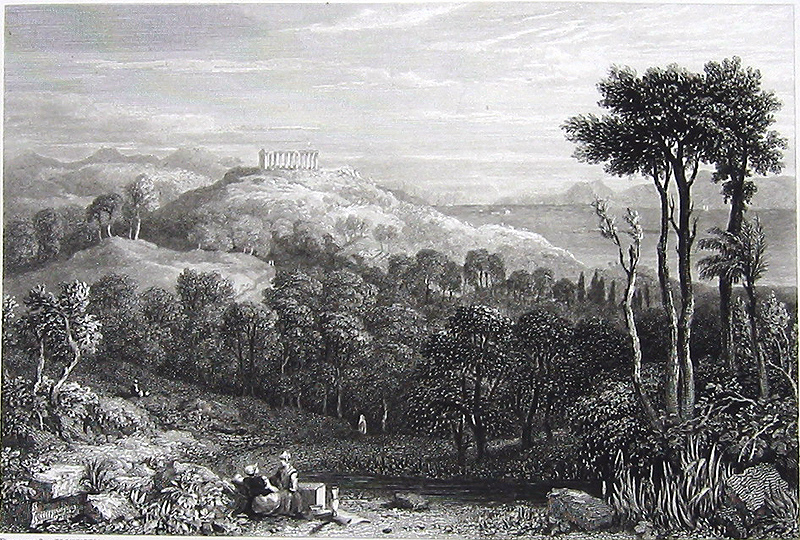|
TEMPLES OF JUPITER PANHELLENIUS AEGINA Artist: Drawn By H. W. Williams ____________ Engraver: W. Miller |

We pack properly to protect your item!
The Temple of Aphaia dedicated to goddess Aphaia and located on the island of Aegina on top of a rock is one of the ancient architectural wonders that is beautiful and preserved in the whole of Greece. It was built in 480 BC and 25 of the original 32 Doric columns still stand due to the skill of the restorers. It is situated in a Sanctuary complex in Aegina about 13 Km east of the main port. The temple was built over the ruins of an earlier temple built around 570 BC that existed at the very site but was later destroyed in the fire in 510 BC. The remains of this old temple were filled to get a larger flat terrace on which to build a new temple. This led to the ruins of the old temple to be well preserved. Many painted remnants are still found. The possibility of another temple built in the 7th century being located at this site is seen but all agree that this temple was very small and simple in terms of both plan and size. Many figurines belonging to the late Bronze Age have been excavated from this site especially female figurines showing that cult activity existed at this site from 14th century BC connected to a Minoan civilization. The last temple has an unusual plan and is noted for their beautiful sculpture that shows a remarkable progress from Archaic to Early Classical techniques. The sculptures are on display in Glyptothek of Munich and a large collection of fragments are located in the museums at Aegina on the site. Historical evidences point to the fact the people of Aegina by the second millennium was already worshipping a deity at this site. By the end of second millennium the Dorians colonized Aegina and they continued the worship of the goddess. During the Greek period worship of Aphaea began. The legend has it that Aphaea escaped the clutches of sailors near the coast of Aegina and was seen going up till she vanished and hence the name Aphaea meaning “vanish”. Aphaea is said to be a mountain and a hunting goddess who protects shipping. Aegina was an important shipping area of the region. The maritime prosperity of Aegina during the sixth and fifth century is the reason for the beautifully built Temple of Aphaia at Aegina. There were many theories regarding the temple of Aphaia. When initially discovered in the 18th century after years of oblivion and disuse, it was thought to be temple of Zeus Panhellenius and was then attributed to Athena. Only later when a relic from the temple containing the inscription that stated, “The house and altar for Aphaea were built at the time when eiotes was priest: the ivory was added, and the enclosure put up” was found that speculations were laid at rest and the temple was attributed to Aphaia. The sanctuary here consist of many buildings not just the temple. The temple lay at the center of the enclosing walls. A large alter with paved pathway and a ramp leading to the temple was found east of the temple. Four bases, two on either side of the ramp are seen. These were probably meant for statues. The alter was used to burn offerings. On either side of the alter are found foundations of two buildings which may have been open buildings to house more statues. In the northern side is a cistern to collect rain water from the roof of the temple. Near the cistern is found a large column with a sphinx on top. It was believed to have been built around 600 BC and the height of the column is about 14 meters. It is the only remains of the older sanctuary that existed there. The sanctuary was situated on a flat terrace. At the entrance towards the south was a columned gateway. The southeast building seems to have been used for administrative purposes. The temple had 32 columns twelve on each side and six at the front and back. The columns on the sides incline inwards slightly (about 3/4 inches) to lend greater strength to the building. And the columns at the angles are about ¾ inches thicker than the others. Limestones found in Aegina were used to build the present temple and they were covered with a thin layer of stucco that was richly painted. The upper parts of the temple are more colorful than the lower part. These are painted in bright shades with horizontal elements in red and vertical in black. Carved wooden plaques that were painted or embellished with bronze relief may have filled the metopes on the frieze. The upper surfaces of the horizontal cornice were usually painted in red representing earth and the background in cobalt blue to represent sky. The temple constructed at the archaic period display both archaic and classical styles.